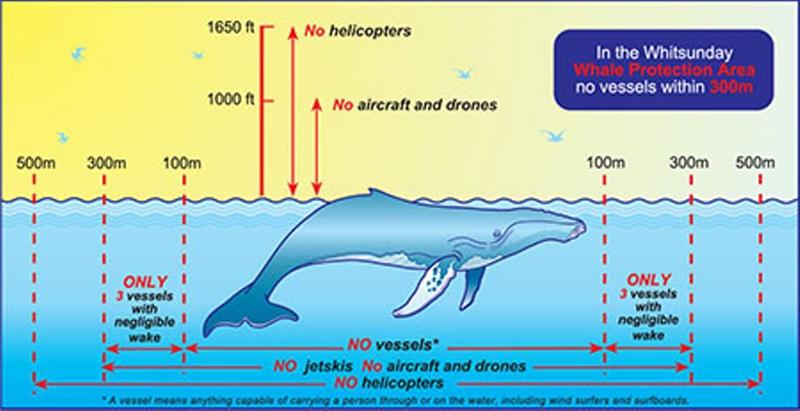
Watch out for whales
by GBRMPA Media 22 Jun 2018 01:07 UTC

Whale watch distances © GBRMPA
Few wildlife experiences could compare to the sight of a massive whale majestically rising out of the water and flopping backwards, or a pod of dolphins playfully showing off their acrobatic skills.
The Great Barrier Reef is a vitally important breeding ground for about 30 species of whales and dolphins (or 'cetaceans'). One of the most commonly sighted whales are the massive humpbacks which make the trek to the Reef's warmer waters from Antarctica between May to September to court, mate, give birth or rear their calves.
It's critical for their continued survival that their 'nurseries' are available to them, free from any harassment which may lead to calf mortality.
As someone who shares the waters with the Reef's precious cetaceans, you have a responsibility to help protect them and to keep safe distances (refer to diagram below).
By following these responsible practices when you're in the vicinity of whales and dolphins, you're not only playing a big part in their conservation but you're also providing a safe environment to watch them.
Report sick, injured, stranded or dead whales or dolphins. Also report if your vessel accidentally strikes a whale.
When boating around whales
- Be alert and watch out for whales at all times, particularly during whale migration season (May to September)
- Post a look out to keep an eye out for whales if they are suspected in the vicinity
- Do not approach or disturb mothers and calves – never place a boat between them
- Always move in a parallel direction to the whale or dolphin
- Do not use engine sound or speed to attempt to influence the behaviour of a whale
- When you're leaving an area where whales were present, turn the motor on, post a look out, and move off slowly
- Slow down to minimise the risk of collision where whales have been sighted
- Report any boat strikes and reassure your passengers that the relevant authorities have been contacted to assist the whale.
When boating around dolphins
- Do not intentionally drive through a pod of dolphins to try to get them to bow-ride – some dolphins don't bow ride, and can become disturbed near boats
- If you do come across dolphins bow riding, maintain a constant speed and direction.
When viewing whales and dolphins
- Never try to overtake whales or dolphins
- Avoid making sudden noise, speed or direction changes
- Be quiet when you are near a whale or dolphin
- Let the whale or dolphin control the situation – do not try to round up or herd
- Move away immediately if the whales or dolphins suddenly change behaviour and appear agitated.
Behaviours that indicate that boats should move away include:
- Bumping the vessel
- Rapid changes in swimming direction or speed
- Erratic behaviour
- Escape behaviour such as prolonged deep dives
- Tail slapping or swishing.
Marine Parks Legal Requirements
- All whales and dolphins in the Great Barrier Reef Marine Park are legally protected
- When operating a vessel or aircraft check safe distances diagram (above).